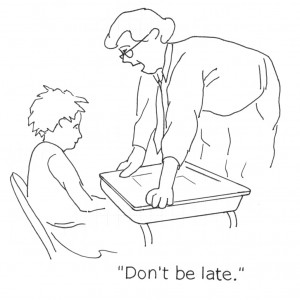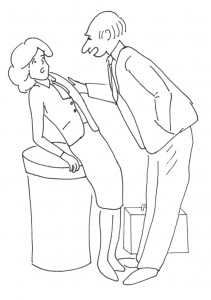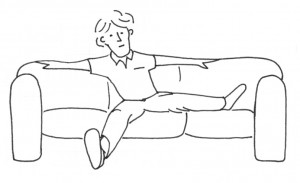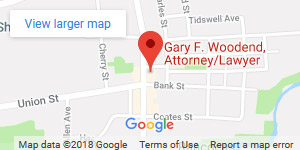Lesson Fourteen — Body Language
There are many ways to communicate with one another. The most common is verbally through the spoken word. We do this every day of our lives. The words themselves, however, are only a part of the message. Suppose, for example, you were late for homeroom, and your homeroom teacher, while making notes in her attendance book, without looking up, calmly says to you “Don’t be late for class again. “Suppose instead, that same teacher slams the attendance book on her desk, walks up to your desk, grips your desk firmly with both hands and leans over with her nose a half inch from yours, breathing in your face, and calmly says, “Don’t be late for class again.” I think you will agree that there is a substantial difference in the two messages. What is the difference? Although the words and tone are the same, the non-verbal threat is unmistakable in the second scenario. We call this “body language”.

Suppose, you ask your little brother if he saw your Backstreet Boys CD, and he looks you in the eye and says, “No.” Suppose, on the other hand, he puts his hands in his pockets, slumps his shoulders, hangs his head and says, “No”. Which answer is most likely to have you ransacking his room looking for the CD? Again, the words are the same. The difference is body language.
You already know how to read and interpret many body language signals. You already know the simplest, most common and most recognizable body language symbol. People have been using it since the beginning of time. As far as I know, it is used in all cultures all over the world. No, it is not a hand gesture. It is a smile. It is probably the most powerful body language tool available to mankind. We use it all the time. Imagine how much more money smiling waiters and waitresses make than their straight-faced co-workers, and how few non-smilers get dates for the prom.
You can use it anywhere, on anyone, at almost anytime. I say almost anytime because I remember being called down to the vice-principal’s office in high school for throwing some small object out of the second-floor, classroom window. I mean, allegedly throwing an object out the window. While being reamed out by the vice-principal, I mistakenly flashed a beautiful, bright, full-toothed smile. I just couldn’t help it! This did not help my predicament at all.
In spite of this incident, I am convinced that a smile, applied correctly, is a marvelous tool. Every sales and customer service training program in the world emphasizes the importance of a smile. Why? Because they know how effective a smile can be in breaking down barriers, in making others feel comfortable. When you wear a smile, you send out signals that you are friendly and likeable. Best of all, a smile is free! It costs you nothing and gets you plenty.
There are many other body language signals, most of which you are already familiar with. Others are not so obvious. If you want to learn more about these subtle body language messages, read on. You will surely be able to use them to your advantage. Let’s take a look at some.
Personal space is an important element of non-verbal communication. It varies from person to person and from culture to culture. I am sure you have been in situations where someone is standing so close to you while speaking that you move back slightly, but then they move toward you. You feel very uncomfortable because they are invading your personal space. If they have bad breath, it is even worse! The comfort distance varies from person to person and from culture to culture.
Were you ever at a restaurant with extra seats at your table and a stranger came and sat down at your table to eat? I doubt it, but in some countries this is perfectly acceptable. In others, like the U, S of A, it would be outrageous behavior. Have you ever been in an empty movie theater or a bus where there are plenty of open seats and some stranger comes and sits down in the seat right next to you? The creep is invading your space. We have an expectation that others will respect our space.
When eating in the cafeteria or studying in the library we expect that we will each use up only the space in front of us. If your neighbor spreads out into your space, you get agitated and can’t concentrate on your work. I am sure you know what I mean.
Take a look around you. Every day you can see how others are defending or sharing their personal space. Even though we may not be able to hear what they are saying, we can get a pretty good idea about what type of relationship they have. I recently saw an older man talking to a younger lady in the hallway of a courthouse.(This is where I spend a good deal of time since I am a lawyer.)The gentleman was speaking quietly so I could not hear what he was saying, but the young lady was leaning back against a trash can as far away as she could possibly lean without falling over backwards, with her arms folded across her chest and a very distraught look on her face. I could tell she was uncomfortable with the amount of space he was leaving her. I saw her a few minutes later without the gentleman and asked her who he was. She said, “He’s my attorney, why do you ask?” I told her I saw her leaning back against the trashcan and thought she was going to fall over. She laughed and said, “Yeah, what is with that guy? He was telling me to relax, but how could I relax with him right in my face like that!”

At other times, you will see a boy and a girl very close together, appearing to be quite comfortable. They don’t seem to need as much personal space between them, so it is probably safe to say that they are very good friends, possibly even boyfriend and girlfriend. In fact, by observing the amount of personal space between two people, you can often tell how they feel about each other before they even know themselves. The less personal space between them, the more comfortable they are with each other, and most likely, the more they care about each other. Unless, of course, they are snarling at each other, in which case a fight is probably about to break out.
This applies to you as well. If there is a particular guy or girl that you like but don’t know how they feel about you, you can get a pretty good idea by gradually invading their personal space. This can be a good test before you embarrass yourself by asking them out on a date. If you move into his or her space, but they lean or move away, you probably have a little more work to do before popping the big question. If not, you’re in good shape. Try it. It can be fun.
An invasion of personal space can also be used as a weapon under the right circumstances. Just like the homeroom teacher I mentioned earlier in this section, the invader may intentionally want to make someone feel uncomfortable. Generally, the invader gets the advantage. The police frequently use this to make the suspect being questioned feel threatened and, hopefully, more frightened and more truthful. The police invade; the suspect feels uncomfortable and retreats. The suspect is uncomfortable, gets nervous, makes mistakes, gets confused, and gets caught in a lie. On the other hand, if they want to act like the good guys and gain the suspects confidence, they will lean back in the chair, unfold their arms, put their feet up. Now, they are best buddies. It’s all body language. You can do the same thing. Hopefully, you will use all of these techniques for good instead of evil.
Touching is very important. It communicates to others that we like them, we trust them, they are important to us. Touching is a great tool. I don’t know for sure, but I believe this is why we have the custom of shaking hands when we meet someone. It is a gesture of friendship. You can say a lot with a handshake. If you shake hands like a wet noodle, people will think you are weak and submissive. And, they probably are right. If you shake hands firmly, you will seem strong and confident and proud. Possibly even trustworthy, particularly if you look the person in the eye and say, “It’s nice to meet you”, or something like that. That seems like an awful lot of importance to put on a handshake, but it is true.
There are different kinds of handshakes. If you extend your hand with your palm somewhat facing upward, that is a gesture of friendliness and acceptance. If you extend your hand with the palm down, you are offering to take a dominant role. If you shake hands with two hands, in other words, extending your right hand while placing your left hand on top of the hand and wrist of the other person, you are showing that you are really, really happy to be greeting this person. If you shake hands with your right hand while placing your left hand on the shoulder of the other person, this shows that you are superior in rank to the other person and have confidence in the other person.
You can often judge the relative rank of people by observing other nonverbal clues. Take three examples. During class, a teacher from down the hall knocks on your classroom door. Your teacher says, “Come in”. The knocking teacher opens the door, stands in the doorway and asks a question. The next day, there is a quick knock on the door, and the knocking teacher enters without being asked. Then walks halfway up to the desk and asks the same question. The very next day, a third teacher walks into the classroom without knocking, walks straight up to your teacher’s desk, leans on the desk with both hands and asks the same question. What can you tell about the relative status of these teachers in all three situations? Which teacher is the rookie? Which teacher is of equal status? Which teacher is the department supervisor or principal?
If you ever get called down to the principal or dean’s office, try this. Walk in, have a seat, put both hands behind your head, and put your feet up on his or her desk. What do you think will happen? Chances are this will not go over so very well. Touching someone else’s stuff, particularly if you put your feet on their stuff implies that you outrank them. I am sure you can think of other examples. This is all nonverbal communication, in other words, body language.
While you are in the principal’s office, try standing up while the principal sits. Chances are this will make the principal feel very uncomfortable because standing puts the seated person in a more vulnerable position, and puts the standing person in a superior position. This is an old trick. You sit. They stand, or sit on their desk. They are big and powerful. You are small and weak. These are all examples of nonverbal communication.
Are you ready for more? Here goes?
Folding your arms across your chest is a common body language signal, but it can mean many things. The popular interpretations are, “I’m angry.” “I’m not buying your story.” “I’m closed, stay away.” Or, “I’m cold, turn up the heat.”
Leaning forward while seated across from someone shows that you are very interested in them and what they have to say. Leaning away could be interpreted as indifference or disbelief.
Seating arrangements are also interesting to observe. Take a look at two people sitting on a three-cushion couch. Are they sitting next to each other? Are they sitting at opposite ends of the couch facing toward each other? Or are they sitting at opposite ends facing away from each other? In the first example, sitting next to each other, they are obviously comfortable with each other and probably dating. In the second example, they feel comfortable with each other, but are not dating, at least not yet. In the third example, they do not feel comfortable with each other at all and there is not much hope that they will ever be dating. In fact, they may not have much hope of dating anyone if they feel uncomfortable about being that close to someone.
Suppose you have one person sitting on a couch.If the person is sitting at one end or the other, this means they are non-verbally saying, “Come join me.I don’t mind”, or perhaps, “I would like some company.”On the other hand, if a single person is sitting in the middle of the couch, they are saying, “This is my couch. I am not interested in talking to you or anyone else. Stay away.”

The same applies to a cafeteria or library table. If the person sits in the middle seat at the table and spreads out or puts some belongings on the chairs next to him or her, they are sending a definite message that they do not care to have company. Similarly, if the person sits at one end or the other and has the chairs nearby pulled out slightly, chances are they are in the mood for company. You have probably done this yourself, without even realizing it.
So, why is all of this important to you? Because, not only is it important for you to accurately read the subliminal signals sent out by others, you must be aware of the signals you are sending out, intentionally or not. If you are receptive to others and want to make friends, you have to send out the right signals. When getting on the bus, sit over near the window, leaving the aisle seat open so that someone can sit down next to you. But, don’t stare out the window. If you sit in the aisle seat, you are saying, “Leave me alone.” If you want to get to know someone better, lean forward, and unfold your arms, even if you are cold. Shake hands firmly. Touch people to let them know that they are important and you like them. Do not invade the personal space of others until you are sure you are welcome to do so. People read the non-verbal signals sent by you to them and act accordingly.




